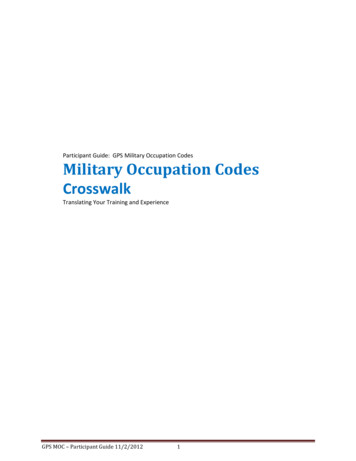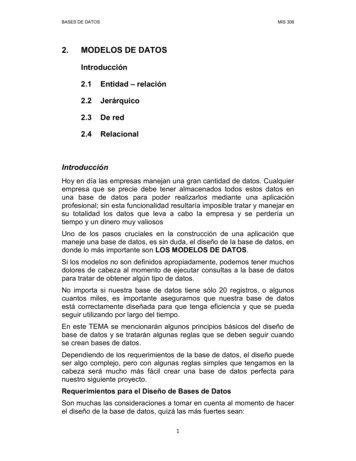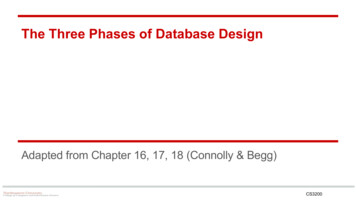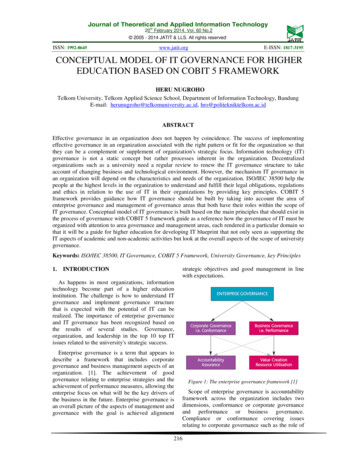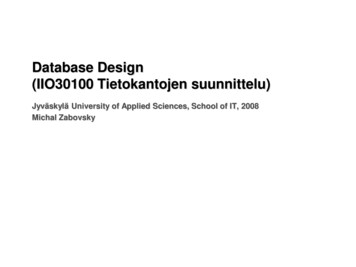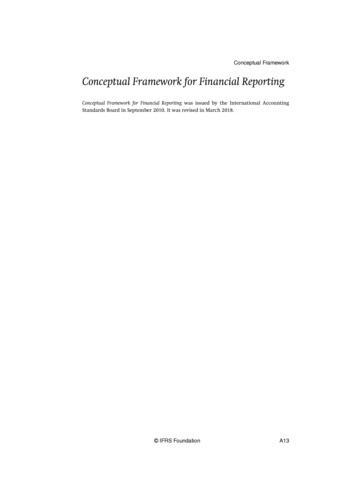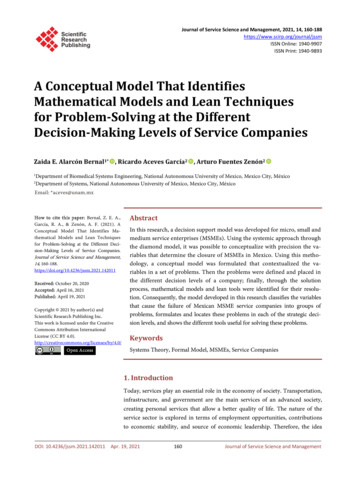
Transcription
Journal of Service Science and Management, 2021, 14, 160-188https://www.scirp.org/journal/jssmISSN Online: 1940-9907ISSN Print: 1940-9893A Conceptual Model That IdentifiesMathematical Models and Lean Techniquesfor Problem-Solving at the DifferentDecision-Making Levels of Service CompaniesZaida E. Alarcón Bernal1* , Ricardo Aceves García2 , Arturo Fuentes Zenón212Department of Biomedical Systems Engineering, National Autonomous University of Mexico, Mexico City, MéxicoDepartment of Systems, National Autonomous University of Mexico, Mexico City, MéxicoHow to cite this paper: Bernal, Z. E. A.,García, R. A., & Zenón, A. F. (2021). AConceptual Model That Identifies Mathematical Models and Lean Techniquesfor Problem-Solving at the Different Decision-Making Levels of Service Companies.Journal of Service Science and Management,14, ceived: October 20, 2020Accepted: April 16, 2021Published: April 19, 2021Copyright 2021 by author(s) andScientific Research Publishing Inc.This work is licensed under the CreativeCommons Attribution InternationalLicense (CC BY en AccessAbstractIn this research, a decision support model was developed for micro, small andmedium service enterprises (MSMEs). Using the systemic approach throughthe diamond model, it was possible to conceptualize with precision the variables that determine the closure of MSMEs in Mexico. Using this methodology, a conceptual model was formulated that contextualized the variables in a set of problems. Then the problems were defined and placed inthe different decision levels of a company; finally, through the solutionprocess, mathematical models and lean tools were identified for their resolution. Consequently, the model developed in this research classifies the variablesthat cause the failure of Mexican MSME service companies into groups ofproblems, formulates and locates these problems in each of the strategic decision levels, and shows the different tools useful for solving these problems.KeywordsSystems Theory, Formal Model, MSMEs, Service Companies1. IntroductionToday, services play an essential role in the economy of society. Transportation,infrastructure, and government are the main services of an advanced society,creating personal services that allow a better quality of life. The nature of theservice sector is explored in terms of employment opportunities, contributionsto economic stability, and source of economic leadership. Therefore, the ideaDOI: 10.4236/jssm.2021.142011 Apr. 19, 2021160Journal of Service Science and Management
Z. E. A. Bernal et al.that a new experience-based economy will replace post-industrial society is considered, referring to a society that defines life quality through services such ashealth, education, and entertainment.Service companies charge primarily for memorable customer contact. Experiences are characterized by the environment and user participation in them.Consequently, innovation and social trends based on changing demographicscreate demand for new services. Globalization and the current pace of life meanthat services are considered standard, making the difference with the excellencewith which they are delivered. When a customer buys a service, they need to satisfy an essential need and demand to go beyond it. In other words, what theyneed is a shopping experience.Considering that services are ideas and concepts, and their products are sensations and experiences, service innovations are not patentable, so service companies must continuously optimize their processes and innovate. This intangibility also brings problems for the user because when you buy a product, you cansee it, feel it, and test its performance before buying it. Meanwhile, for a service,the user must trust the company’s prestige that sells it and its experience with it.The combination of the service’s intangible nature and the user’s participationin the service delivery system results in a variation of the service from user touser. Therefore, for companies of this type, the process is the product, and thedevelopment of standards, performance measures and employee training in theprocedures are a way to ensure consistency in the service provided.In service companies, a distinction must be made between inputs and resources. For services, inputs are the users, and resources are the value proposition being delivered, the employees’ work, and the capital in command of theservice administration.The world economy is increasingly characterized as a service economy. This ismainly due to the growing importance and participation of the service sector inthe economies of most developed and developing countries, so that service sector growth has been considered an indicator of a country’s economic progress.In Mexico, of the total number of companies that exist, 85.8% are servicecompanies and provide 63.9% of the jobs, contributing 62.9% of the country’sgross domestic product (INEGI, 2019). In terms of size, micro-businessesrepresent 95.8%, small businesses of 3.5%, medium businesses 0.6%, and largebusinesses, which are at a rate of 0.1%. This implies the importance of SMEs fordevelopment and employment in Mexico (INEGI, 2019).However, in Mexico, service companies have a high mortality rate, establishing that out of every ten companies that are opened, three die in the same year,six in the second year and seven in the fourth, and only three survive to thefourth year (INEGI, 2019). According to (Dávila et al., 2014), the most commoncauses of death for these companies are poor location, no market study, poorplanning, excess operating expenses, no analysis of their processes, and lack ofperformance indicators, among others.DOI: 10.4236/jssm.2021.142011161Journal of Service Science and Management
Z. E. A. Bernal et al.Another important aspect to consider is the educational level of the owners ormanagers of MSME, which according to (Peña et al., 2017), 47.5% only havesome primary and secondary education, 24.8% have a higher technical level, andonly 23.7% have a high school education considering that the rest do not haveany type of studies.On the other hand, according to Santander MSME-México (Santander, 2019),in its article “Mejores ideas para franquicias exitosas en 2019” it is establishedthat this type of business has a higher degree of durability. It establishes thatfranchises have a survival rate of at least 8.5 years, much higher than traditionalMSME. Raising the question: why do franchisees get such good results? Furthermore, the answer they established was because they have: training and assistance, constant evaluation, marketing, networking, operation, and location manuals. Consequently, and in general terms, these aspects make the franchises avery profitable MSME service model.In consequently and due to the information presented above, entrepreneursand administrators of traditional MSME must have some alternative that provides them with the knowledge, the necessary tools, and technical support sothat they can develop their work and this type of company can survive for alonger period and be a profitable business.Therefore, this work seeks to develop an alternative that serves as a guide andtraining for managers and entrepreneurs of MSMEs to solve their problems atthe three levels of decision: strategic, tactical, and measurement.One of the reasons is because of the great opportunity. Empirical data hasshown that the cost of services is inflated by 30% - 80% waste, i.e., processes areplagued by activities that add no value from the customer’s perspective. Our article on Lean Models and Tools for Service Businesses is needed because servicefunctions need tools like mathematical models, Lean Six Sigma, data skills, andprocess thinking.2. Literature ReviewThe interest and generation of knowledge about service businesses is a very recent field of research and application, which began in 2004 under IBM’s tutelageunder the concept of Service Science (Barile & Polese, 2010b). The concept of aService System has provided the stakeholders in this field of knowledge to visualize services as a set of interactions between suppliers and consumers that together create value for themselves, i.e., as a system—considering as a final objective, to apply scientific knowledge in the design and improvement of service systems for business and social purposes (such as efficiency, effectiveness, and sustainability).Through the literature, the use of lean tools and mathematical models hasbeen identified to provide the necessary basis for Service Science (Barile et al.,2010) in general and service systems in particular. Under this perspective, thevast majority of authors have limited themselves to expressing the application ofDOI: 10.4236/jssm.2021.142011162Journal of Service Science and Management
Z. E. A. Bernal et al.some lean tool or mathematical model in the field of knowledge of services,without offering precise guidelines to guide the analyst in defining the tool ormodel of interest for decision making.In this context, the term “service” covers both service organizations (healthcare, banking, government, retail) and the service infrastructure of service andmanufacturing organizations (marketing, sales, accounting, contracting, production control, engineering, research, and development, etc.). That is, everythingexcept “the manufacture of goods and articles by hand or especially by machinery” (i.e., direct manufacturing processes).There is little information in the literature about the range of mathematicalmodeling applications and the use of lean tools in different service topics, themost frequent being those related to health systems (Healthcare). There is literature where it is presented together with mathematical models and lean toolsfor solving problems in different topics about services, being mainly books, being the most focused on service topics, the following.Bordoloi, S., Fitzsimmons, J. A., & Fitzsimmons, M. J. (Fitzsimmons et al.,2008) raises service management to obtain a competitive advantage and providesan approach to each management issue. It recognizes that integrating technology, operations, and human behavior is fundamental to the effective managementof services. It emphasizes the need to continuously improve quality and productivity to compete effectively in a global environment. Process improvement,tools, and programs for continuous improvement are described, and serviceproductivity is measured using data envelope analysis. The strategic importanceof service facilities’ location is presented with analytical models dealing withqueue management from a psychological point of view. The fourth part is dedicated to quantitative models for service management, addressing capacity planning using queue models, and addressing service demand forecasting using exponential smoothing models, concluding with service inventory management.Michael L. George (George, 2003) indicates that the paradigm that translatingmethods into service environments is more difficult than it needs to be is broken. Almost all Lean and Six Sigma applications are for services and transactions. The case studies presented show how Lean Six Sigma can be used in service organizations effectively as in manufacturing and with even faster results.This reference establishes how classic Lean tools, for example, “drive systems”and “configuration reduction,” are used in procurement, call centers, operatingrooms, government offices, R & D, etc. This book provides real-world examplesof situations where the critical determinants of quality and speed are the flow ofinformation and the interaction between people. In Part I: Lean Six Sigma isused for strategic advantage in service. Part II: Lean Six Sigma is implemented inservice organizations and describes successful implementations’ basic elements.Part III: Service Improvement shows how Lean Six Sigma methods and toolswork in real-world service applications.Locher, D. (Locher, 2011) aims to provide a guide for students and applicatorsDOI: 10.4236/jssm.2021.142011163Journal of Service Science and Management
Z. E. A. Bernal et al.of Lean Six Sigma methodologies and tools. The book is designed to engage thereader by allowing hands-on experience with real-life Lean Six Sigma projects ina safe environment, where experienced Black Belts and Master Black Belts canhelp guide students in Lean Six Sigma. The case studies are designed to allow thestudent to work through the exercises and provide enough background information to apply the tools as if they had collected the data themselves. Case studydiscussions provide questions that allow students to compare their solutions toactual results obtained by similar students struggling to learn and apply Lean SixSigma. The reference provides an overview of Lean Six Sigma and the DMAICmethodology and problem-solving tools applied to transaction-based servicesand processes and an overview of Design for Six Sigma and the IDDOV designmethodology applied to transaction-based services and processes.Haksever, C., & Render, B. (Haksever & Render, 2013) covers a wide range oftopics in managing service organizations and their operations. It focuses on value creation and customer satisfaction. Therefore, the book is designed to providecomprehensive coverage of topics relevant to that end. Its content is quite different from traditional operations management textbooks, although we have alsoincluded some of the topics covered in those books. The discussions are basedon the knowledge and experience of various business areas and non-businessdisciplines. For example, discussions are often based on strategy, marketing, international management, human resources, management science, economics,psychology, and sociology. It is hoped that this multidisciplinary and multifunctional approach will help managers and future managers develop a thorough andsolid understanding of the complexities of services and their management. It begins with an introduction and focuses on developing a thorough understandingof services. It discusses the nature of services and service encounters. It also examines clients and their needs and the factors that influence their decisions inpurchasing services. It addresses issues related to value creation and servicestrategy. Finally, it presents various quantitative and technical tools for managing service operations, such as selecting the right service site and internal design.At Furterer, S. L. (Furterer, 2016) states that it goes beyond the basic tools,deepening in the key concepts of lean as they are applied in offices and services.First, value flow management is presented, followed by chapters on StandardWork, flow, pull level, and visual management. Next, several of the most important lean tools are covered, such as 5S and error proofing. These are appliedwhile implementing the key concepts covered in chapters 1 through 5 to maximize benefits. The following chapters present a function-by-function review ofthe lean application. Does lean apply to sales and marketing? What about accounting? S cover functions commonly found in most service organizations andthe administrative areas of manufacturing companies. The examples providedshould be applied in the context of the value stream Management to maximizeprofits.Regarding the production of articles on health service topics, we have considered the following literature reviews, conducted for Mexico by Peimbert-GarcíaDOI: 10.4236/jssm.2021.142011164Journal of Service Science and Management
Z. E. A. Bernal et al.et al. (Peimbert-García et al., 2019) and a more general by Vaishnavi, V., & Suresh, M. (Vaishnavi & Suresh, 2020), in which a panorama is presented for theapplication of Lean Six Sigma (LSS) in health care organizations.Peimbert-García, et al. (Peimbert-García et al., 2019) presents an article thatprovides an overview of the penetration of LSS management practices in theMexican health care system, through a survey of 30 hospitals in six states of theRepublic, to which N 258 responded, including senior management and frontline staff. It was found that the penetration of LSS initiatives in Mexico’s healthcare system is still in its infancy since only 16% of those surveyed had participated in an LSS initiative, and these were used equally in public and private hospitals. Also, it was found that while not many respondents had participated inthe LSS project, the practice is not necessarily new to those who have. However,the sustainability of LSS as a management system in the Mexican health systemis questionable since the practices and tools for managing LSS in existing initiatives have not become systematic in daily operations. Looking ahead, LSS initiatives that emphasize improvements in the quality of patient care delivery aremore likely to be adopted by health workers. Perhaps one of the reasons for thepoor spread of LSS is that the country is not experiencing hyper-growth inhealth expenditures as many high-income countries are, even though it accountsfor 6 percent of national GDP, and the industry is not then as regulated as indeveloped countries such as the nearest neighbor, the United States.Nevertheless, the national health care system needs re-engineering interventions that will allow hospitals to be more efficient productive to improve theircosts and the quality of care. For LSS experts and consultants, the Mexicanhealth system represents a blue ocean full of departments and processes waitingto be improved. However, its importance lies in the fact that it is the first research work that evaluates the use of LSS management practices in a LatinAmerican country, and the article is the first to focus on LSS in health care inMexico.Vaishnavi, V., & Suresh, M. (Vaishnavi & Suresh, 2020) work aims to identify,analyze and categorize the main factors of readiness for applying Lean Six Sigma(LSS) in health care organizations, using the technique of total interpretivestructural modeling. The readiness factors are identified and will help managersrecognize areas that lack value and place importance on the successful application of LSS in those areas. The paper also aims to understand the hierarchicalinterrelationships among readiness factors identified using dependency andmomentum. There are 16 readiness factors identified from the literature review,and expert opinions from hospitals are collected. The scheduled interview isconducted based on a questionnaire survey in hospitals in the Indian context todetermine the relationships between preparedness factors. The experts’ opinionsare used in the initial accessibility matrix and the interpretative interaction matrix. The crossover impact matrix applied to the analysis from classification(MICMAC) uses the dependence and momentum engine to understand the hieDOI: 10.4236/jssm.2021.142011165Journal of Service Science and Management
Z. E. A. Bernal et al.rarchical relationship between preparedness factors identified.The result indicates that the culture of client orientation and management ofobjectives are the key factors of preparation for the LSS. The execution techniqueand training are given according to the clients’ current demand and the changeof objectives of the organization. The manager should focus more on readinessfactors to formulate the LSS implementation process to improve the health careorganization. The level of readiness helps the manager identify the target area forLSS implementation. The article’s importance is that although many researchstudies have been conducted on the success and failure rate of implementing thefactors, the importance of the document is that it identifies and will address thereadiness factors related to SLE, especially for the health care industry.Regarding other topics such as financial services, public services, repetitiveprocesses in service companies, problem-solving in service companies, it is notvery abundant, and the following articles were found.Cuatrecasas, L. (Cuatrecasas, 2004) establishes that lean production philosophy has allowed reaching very high levels of efficiency in many of the dimensions related to production systems, both in industry and services. This articledescribes a methodology for evolving from a classical model of a productionsystem’s behavior to one of lean production; this methodology is quite flexibleand can cover a very wide spectrum of production systems. Since service companies are often among those who would benefit from such an evolution, themethodology described here will be applied to a case in the service sector (thecheck-out service of a hotel-type establishment). The methodology also includesa system for calculating the main magnitudes relating to the efficiency of operations and their optimization, step by step. According to the principles of leanproduction (and even, in another order, those of Just in Time), the system implemented is highly efficient and balanced, and it also solves the dynamic assignment of tasks to each job (thus introducing flexibility). The author statesthat it has achieved the optimization of service speed, efficiency, and competitiveness and the elimination of queues, downtime, and other types of waste; wehave also achieved all the flexibility we need.Kung, D., et al. (Kung et al., 2008) work with the installation of water and sewage services is an essential element of many construction projects. With an increasing number of construction projects being undertaken in metropolitanareas, delays are no longer affordable. To increase productivity on these types ofconstruction projects, the workflow must be improved. This paper describes theapplication of “lean planning” principles to improve water and wastewater facilities’ productivity. To illustrate this, a case study is presented that applies theseprinciples to water and wastewater service facilities conducted by the City ofEdmonton’s construction teams. This document also outlines a study that applies recommended lean thinking procedures within a queuing theory model tovalidate the effect of proposed productivity improvements.Setijono, D. et al. (Setijono et al., 2012) introduce a value improvement modelDOI: 10.4236/jssm.2021.142011166Journal of Service Science and Management
Z. E. A. Bernal et al.(VIM) for repetitive processes applicable to any company where people and/orthe company provide a service to support the overall business objective. Arguingthat competitive advantage can be realized through different amalgamations ofproductive and strategic resources, the introduced VIM focuses on resourcegroups’ alignment, influyendo factors to create efficient processes, eficientes andeffective applying Lean thinking and Six Sigma tools and techniques in a moreholistic way. The article introduces the concept of MIV management that develops the “state of the art” and “future state” MIV for a repetitive processespecífico. The conceptual framework presented was put into operation andtested in a case study based on improving the efficiency of asset management ofan interterminal transport system at a busy international airport. About the application of MIVs in the current state and the future, the Plan-Do-Check! Theprocess was established, and the case study presented showed how an analysismethod could be applied to reduce the number of alarm events in the systems.Finally, in this work, the management VIM has been introduced as a visual andsystematic framework that allows managers to understand, evaluate, and improve the repetitive processes within their companies to complement Lean andSix Sigma’s existing conceptual frameworks. Once the research’s potential limitations have been overcome with the single case study presented, future researchshould seek to further develop the approach in other business environments,such as manufacturing and other service industry applications.Vlachos, I., & Bogdanovic, A. (Vlachos & Bogdanovic, 2013) evaluate wastemanagement practices using a sample of small and medium-sized hotels in 19European countries. Seven value stream maps were evaluated, namely Mappingof process activities, Supply Chain Response Matrix, Production Variety Funnel,Quality Filter Mapping, Demand Amplification Mapping, Decision Point Analysis, and Physical Structure, with particular reference to guest booking and reception, and hotel procurement systems. The hotels were found to apply valuemapping techniques, and similarities were found in hotel operations, regardlessof location. It is suggested that all value stream mapping techniques (except theproduction variety funnel and supply chain response matrix) can significantlyimpact waste detection and disposal both upstream and downstream of the valuechain. The paper concludes with a discussion of management and research implications.Lin, J. H., & Chiu, M. C. (Lin & Chiu, 2015) consider that the health systemplays an important role in our daily life. A well-operated health system can savelives and provide a good working environment for medical personnel. However,most health systems suffer from a high workload of medical staff and low clientsatisfaction. Also, the stochastic nature of health services is difficult to evaluateperformance. Therefore, this study aims to implement lean management in thehealth system with lean techniques and a stochastic model to simultaneouslyachieve client satisfaction and waste reduction. The first step is analyzing thecurrent process and data collection to clarify the current status by quality management practices and lean tools. Besides, a stochastic mathematical programDOI: 10.4236/jssm.2021.142011167Journal of Service Science and Management
Z. E. A. Bernal et al.ming model is developed to optimize the performance of this health care system.The simulation results show that efficiency of the process flow after leveling isimproved by about 19.97%, the proportion of workstation downtime is improved by about 41.64% and 22.47%, and the average flow time is improved byabout 4 minutes. A case of the health examination center is applied to demonstrate the benefit of the proposed method. This study could be the first studythat implements the health system’s lean and stochastic characteristics in a mathematical model. This model can serve as a decision support system and can beapplied to other lean improvement service systems.Vashishth, A., et al. (Vashishth et al., 2019) establish as the purpose of this article to explore the trend and most common issues in the application of Lean SixSigma (LSS) in the sector financiero, and also to identify the gaps in issues thatmay be preventing organizations from identifying beneficios of their LSS strategy and develop an agenda for future research on LSS issues. The research isbased on a systematic literature review of 30 articles were published on LSS inthe sector finance, from 2005 to 2015. Many important themes and issues haveemerged through this review, which is from beneficio, motivational factors, constraints, and reasons for implementing LSS in organizations from financieras.The review identifica many gaps and limitations that need to be explored as future research since little has been written about LSS as a holistic strategy forbusiness improvement. Practitioners need to know the benefits of LSS, its limitations, and the motivational factors before beginning the implementation process.This paper is based on a comprehensive review of the literature that allows LSSresearchers to understand some common issues about LSS implementation. Also, highlighting gaps in the current literature and proposing an agenda for futureresearch saves time and effort for readers seeking research topics within LSS.3. The Service Companies in MéxicoIn Mexico, the total number of existing companies (INEGI, 2019) is 4,773,995(2018 figures), of which 85.8% correspond to service companies. These give jobsto 63.9% of a total of 26,561,457 people, and their contribution to the nationalGDP in 2018 corresponded to 62.9% of 23,524,509.6 million pesos.If only service companies are considered, out of a total of 4,096,051 existing in2018 (INEGI, 2019), micro represents 95.8%, small 3.5%, medium 0.6%, andlarge 0.1%. As for the employment they generate in the country, out of 16,972183 jobs, the micro ones occupy 50.3%, the small ones 17.0%, the medium ones15.4%, and the large ones 17.3%. Therefore, their economic and labor contribution is of great importance for the country’s development. In addition to theabove data, service companies have a high rate of failure, establishing that a service company’s life expectancy is 0.33 for one year, 0.31 for two years, and 0.29for four years. In other words, out of ten companies that are opened, three die inthe same year, six in the second year, and seven in the fourth year; only threesurvive the fourth year.Based on the analysis made by (Dávila et al., 2014), the most common causesDOI: 10.4236/jssm.2021.142011168Journal of Service Science and Management
Z. E. A. Bernal et al.for business failure are insufficient income to subsist; lack of performance indicators, lack of an analysis process, poor planning, problems in execution, poorlocation of the company, weak market research, and excess operating expenses.It is clear from this study that 70% of the companies that were not successfulwere service companies.The study carried out by (Peña et al., 2017) analyzes the main factors that determine the closure of micro and small enterprises in Mexico, being these: financial, market, personal and management, external and technology. Also, whenconsidering the level of education of business owners and managers, we have to,47.5% have some primary or secondary education, 24.8% have a higher technicallevel, 23.7% have a bachelor’s degree, and the rest have no studies. This studywas applied to 24,867 active companies, 8430 inactive companies, at municipallevel.In another st
Mathematical Models and Lean Techniques for Problem-Solving at the Different Decision-Making Levels of Service Companies Zaida E. Alarcón Bernal1*, Ricardo Aceves García2, Arturo Fuentes Zenón2 1Department of Biomedical Systems Engineering, National Autonomous University of Mexico, Mexico City, México

